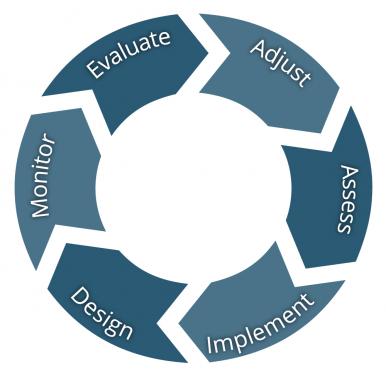The Adaptive Management Plan (AMP), which provides a systematic process to test hypotheses and apply the information learned to improve management decisions, is central to successful program implementation.
The AMP is a collaboration between Platte River Recovery Implementation Program partners and cooperators under the guidance of experts from around the country and is centered on priority hypotheses that reflect different interpretations of how river processes work and the best approach to meeting program goals.
The AMP’s Integrated Monitoring and Research Plan (IMRP) will guide implementation of monitoring and research protocols to test the joint priority hypotheses and guide Program restoration and management decisions.

This diagram outlines the basic procedural steps of Adaptive Management, a systematic process of “learning by doing”.
Adaptive Management Process as Applied to PRRIP
This process involves evaluation of alternative hypotheses through the application of an experimental management program, and improving management decisions in ecosystems based on knowledge gained from those management actions. Adaptive Management is central to the Platte River Recovery Implementation Program (PRRIP or Program). The process of Adaptive Management is utilized in situations where it is uncertain how actions taken will affect the outcome, but decisions regarding management actions must be made despite the unknowns. Monitoring and directed research are designed to reduce uncertainty and move decisions forward. It is a process of using the best available science to test hypotheses, implement management experiments or actions, learn from the results and revise actions as required.
Priority Hypotheses
The Program’s AMP is built around an Applied Science Strategy based on numerous priority hypotheses that represent different concepts about how the Platte River system functions and how the system may respond to Program management actions. For example, one priority hypothesis states: “Additional bare sand habitat will increase the number of adult least terns.” Adaptive Management can be applied to test this hypothesis by:
- Assessing the problem: How much sand is available? What river processes are important?
- Designing and Implementing experiments to create bare sand habitat
- Monitoring the affected species and the defined habitat
- Evaluating the results of the experiment – this includes analyzing data on tern nest success, number of terns nesting on bare sand, availability of bare sand, etc.
- Adjusting management actions based on the results and then beginning the process over to learn more about the river system and improve future management decisions.
Management Objectives
There are four main AMP management objectives:
- Improve production of interior least terns and piping plovers from the central Platte River
- Improve survival of whooping cranes during migration
- Avoid adverse impacts from Program actions on Pallid Sturgeon populations
- Provide benefits to other species that use the Platte River and reduce the likelihood of listing those species.
Applied Science Strategy
Program science is applied in an Adaptive Management framework through an Applied Science Strategy that incorporates the following elements:
- Conceptual Ecological Models – represent broad ideas about how river processes work
- Priority Hypotheses – more detailed representations of species/river relationships and how the system will respond to management actions
- Management Strategies – two different sets of management actions that the Program will apply on the ground to test Priority Hypotheses
- Performance Measures – data points that are used to help decision making (number of terns/plovers, width-to-depth ratio, water flow, sediment, etc.)
- Integrated Monitoring Research Plan (IMRP) – monitoring and research conducted to collect, compile, and analyze data on performance measures.
A key part of the Applied Science Strategy is using data collected through the IMRP to assess progress toward Program management objectives and Priority Hypotheses. The knowledge gained can then be used to guide future management actions to more effectively and efficiently benefit the species.
Management Strategies and Actions
The Program implements two management strategies to test hypotheses:
Flow-Sediment-Mechanical (FSM)
This strategy uses water and other measures to rehabilitate the Platte toward a braided river (broad and shallow with exposed bare sand bars) as the underpinning for maintaining restored habitat. Key actions include:
- Flow consolidation
- Channel widening and vegetation clearing
- Short duration high flows
- Sediment augmentation
Mechanical Creation and Maintenance (MCM)
This strategy uses mechanical means to achieve similar habitat objectives. Key actions include:
- Channel widening and vegetation clearing
- Off-channel sand and water
- Wetlands and wet meadows
Design and Implementation
The Program’s Adaptive Management Working Group and Executive Director’s Office use several tools to design Adaptive Management experiments. Special attention is being paid to experimental design to ensure Program resources are used efficiently and effectively, and that responses to Program actions can be determined in a robust and meaningful manner. It is important that through these experimental efforts we learn more about how to effectively manage our water and land resources for the benefit of the species and the Platte River system.